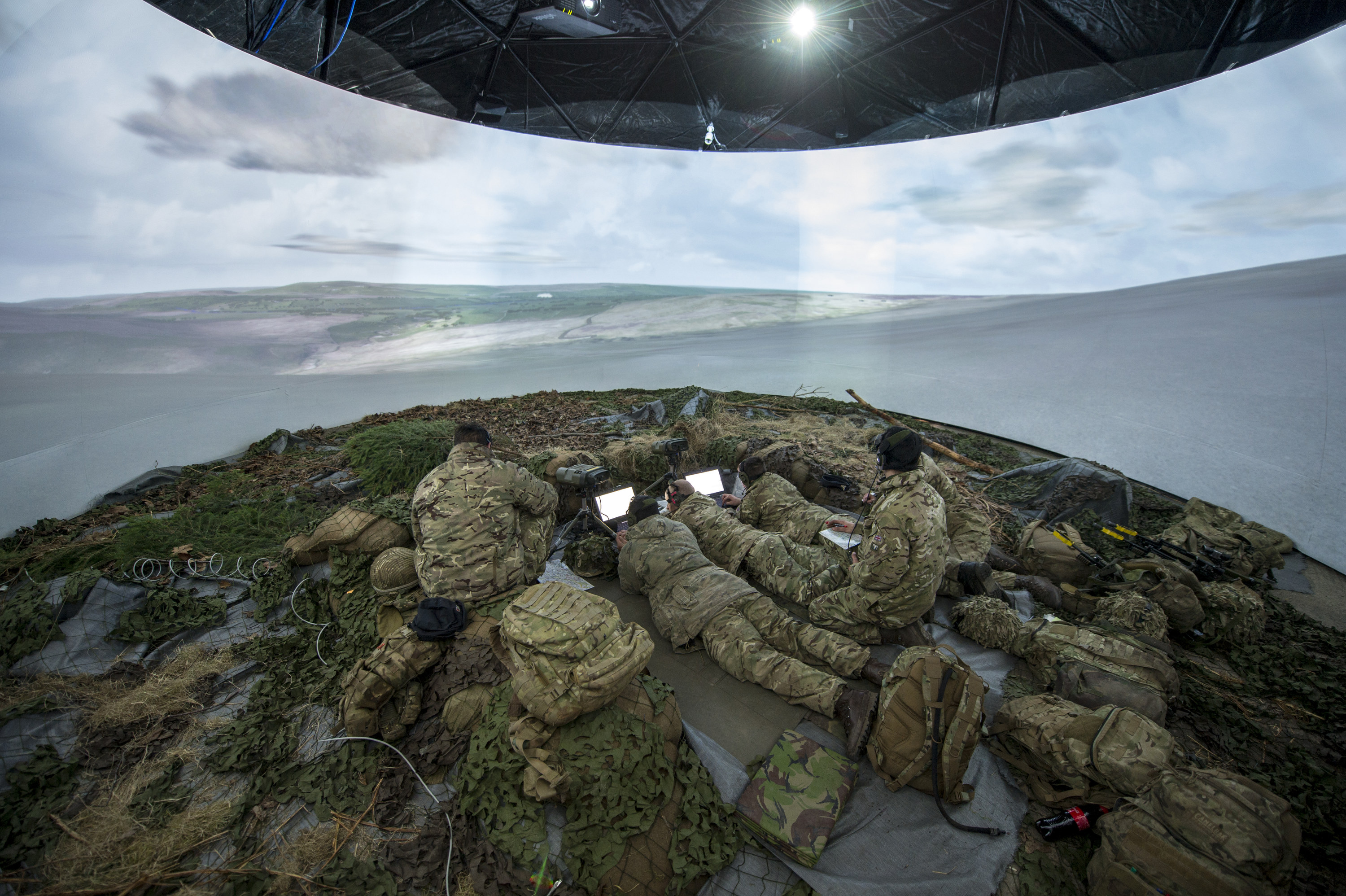There have been substantial advances over the last ten years in the quality of synthetic environment training. Here, MOD DCB features writer Paul Elliott looks at the value of Dstl’s work in synthetic training and its role in developing next-generation training.
The Ministry of Defence spends billions of pounds on training, with visual systems and simulators making a central contribution to defence training for many years. Questions that the Defence Science and Technology Laboratory (Dstl) has been wrestling with for some time surround how to prove the benefits of synthetic training, and how to achieve best value results from what has been invested into military training technology.
Dstl has placed a lot of focus in areas such as Live Virtual Constructive (LVC) training, but the real aspiration is for the provision of a wide range of experiences to help people achieve their training objectives. A lot of Dstl analysis is focused on establishing the right training blend and training media – modelling and understanding training effectiveness and placing this in the context of warfighting. The exploits of this experimentation programme have led to real capabilities.
An analytical approach to synthetic training is vital as it helps measure effectiveness. Training objectives comprise elements such as experiences that build towards competency. If an analytical approach can be taken in respect of that training then it can be modelled, with surveys taken and psychological studies conducted to examine if the experience in question delivered its purpose. There is also a valuable role for snapshot studies in this analysis.
That’s where all-fighter experimentation comes in. Dstl has for a long time been looking at how to drive better value from simulation synthetic training. It has been particularly keen to investigate whether there is any value gained from linking simulators together to achieve distributed synthetic training, running a series of trials as early as 2000/01 to try to demonstrate the value of such linkage. Dstl’s endeavours led to the Mission Training by Distributed Simulation Capability Concept demonstrator, which became the Air Battlespace Training Centre in Waddington, which now delivers air/land integration training on a regular basis.
There have been other notable successes. Dstl has tackled some of the security and architectural problems that combining multiple synthetic assets presents, demonstrating that you can achieve training value through distributed synthetics. This led to the largest UK synthetic exercise research trial to date, in March 2014, called Enduring Sunrise. The exercise involved combining all the facilities at the Air Battlespace Training Centre including synthetic Typhoons and Tornados and then linking them to Typhoons at RAF Lossiemouth, synthetic rotary wing aircraft at Middle Wallop and a Type 45 ops room using the maritime collective at the maritime composite system at HMS Collingwood.
Enduring Sunrise was a high-end mission conducted using all of these assets as far as possible representative of the future Defence Operational Training Capability (DOTC). DOTC projects are MOD acquisition programmes that exploit the advanced research outputs of Dstl’s synthetic environment tower of excellence (SE Tower). Enduring Sunrise demonstrated that this is technically possible, feasible and can actually achieve training value.
The belief in Dstl is that synthetic training, particularly distributed synthetic environment training, can deliver on its promise and provide rich and immersive experiences that fill identified training gaps. Business certainly appears to share this view as seen by the many synthetic training solutions available on the market. In recent years industry has been pushing virtual reality (VR) as a potential training conduit and Dstl has responded to this. Anyone who has taken part in a VR training demonstration will appreciate the immersive qualities it offers in creating a realistic synthetic environment.
However, many of the different devices that Dstl has tested have been procured for specific purposes, and connecting them together can present difficulties meaning it is sometimes actually more difficult to achieve the full potential of the training. Regardless, there is a lot of potential for increasing exploitation in this area, not only regarding synthetics but in moving towards the LVC concept to enhance live training.
Which brings us to next-generation training, driven by strategic requirements as well as technology. Next-generation training is about realising the technologies of the future and leveraging them to deliver training. The technologies that the UK is investing in have to validate and support what the training requirement actually is. In terms of next-generation training, Dstl has looked at live assets connected to virtual assets and exchanging information between the two. When talking about next-generation training what we’re really talking about is developing technologies that are known to work now and putting them into practice.
In the longer term, the DOTC project should come to fruition in 2019, allowing for the networked integration of synthetic platforms across the UK. This will present frontline operators with the opportunity to enter the synthetic battlespace from their own operating bases to exercise with other users in realistic joint operations, free from the constraints and limitations of many live training scenarios. In this way, synthetic training will be used smartly to augment rather than replace live events, helping to ensure that the Armed Forces retain the capability, competency and readiness levels demanded of them.
The use of virtual and constructive simulations allows personnel to train with scarce or high-value assets, and means that live training capabilities can be adapted to meet evolving operational needs. From Enduring Sunrise onwards, the future is what the MOD chooses to adopt as its training regime.
For more information, click here.

